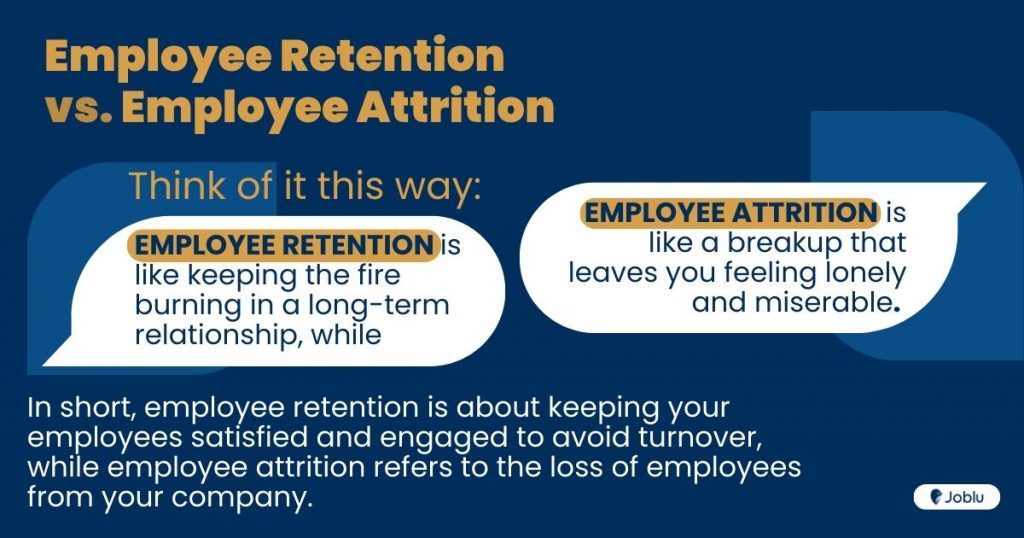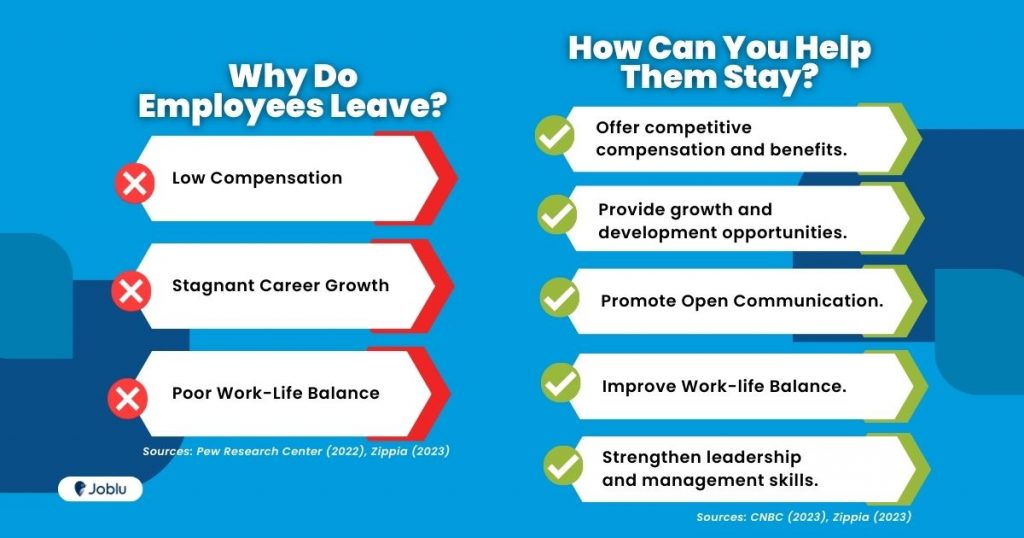In today’s rapidly evolving job market, the need to improve employee retention has become a top priority for businesses across the globe. 2023 data from TeamStage reveals that over half of the enterprises worldwide grapple with the challenge of keeping their workforce intact. As hiring continues to rise at a remarkable pace, employee turnover rates are also escalating, leading to concerning employee retention rate statistics.
The alarming number suggests that more than 50% of employers globally are struggling to maintain a stable and committed workforce. In this blog, we will delve into the importance of employee retention and explore ways to reduce attrition to help businesses create a thriving work environment, and ultimately, reduce turnover rates.
Understanding Employee Retention and Attrition

To effectively address employee retention, it’s crucial to first comprehend the key terms associated with the issue. According to BetterUp, employee attrition signifies the natural decrease in a company’s workforce due to voluntary or involuntary factors, such as resignations, retirements, layoffs, or even terminations. In contrast, employee retention involves the implementation of various strategies and initiatives to keep valuable employees within the organization and minimize turnover.
High attrition rates can lead to negative consequences for a company’s stability and growth. The following points below highlight the importance of reducing attrition because companies can lose manpower, money, and productivity if their employees are not satisfied.
- Financial costs: Employee replacement can be costly, encompassing recruitment, onboarding, and training expenses. Consequently, high attrition rates can place a significant burden on a company’s resources.
2022 data from WorkHuman mentions that employee turnover can cost up to 1.5 to 2 times the salary of the departing employee. However, beyond the evident costs of advertising open positions, onboarding new hires, and making up for lost productivity, there are hidden costs that can substantially influence a company’s workplace culture, among others.
In addressing these hidden expenses and improving employee retention, businesses can save a considerable amount of time, energy, and financial resources. The approach to achieve this might be more straightforward and manageable than one might initially assume.
- Loss of expertise: When skilled employees leave, they take their knowledge and abilities with them, causing a loss of institutional knowledge that could hinder the company’s competitive edge.
A 2022 MarketLogic article highlights that it often takes a new employee approximately two years to reach the same level of efficiency as the individual they replaced. As such, it’s crucial for companies to enhance their data storage and knowledge transfer processes, ensuring that valuable information is effectively passed on to successors and minimizing the negative impacts of employee turnover.
- Impact on morale and productivity: A high incidence of employee turnover can lead to low morale and decreased productivity among the remaining workforce, which in turn, negatively affects overall job satisfaction and engagement.
According to Chron, low employee morale may be a contributing factor to higher turnover rates, as it fosters a work environment where employees continuously look for justifications to move on. In such circumstances, issues like inadequate pay or feeling undervalued can become significant reasons for employees to leave. Moreover, the high turnover rate can initiate a vicious cycle where the morale of the remaining staff declines, eventually resulting in even higher turnover rates as they too decide to leave. Conversely, employees who enjoy a higher level of morale tend to stay with the company, despite potentially less competitive compensation.
Top Reasons Why Employees Leave

CNBC cites 2022 as the “real year of the Great Resignation” with over 50 million Americans quitting their jobs during that year. To better understand the reason behind this staggering number, it’s essential to examine the top reasons why employees seek opportunities elsewhere:
- Low Compensation. A 2021 survey conducted by Pew Research Center discovered that 63% of American respondents attributed their departure from their jobs to insufficient pay.
Employees who perceive their salary as inadequate given their skills, experience, or effort tend to explore more lucrative job opportunities. This sense of being undervalued and undercompensated can result in employee dissatisfaction, diminished motivation, and ultimately, their decision to leave their current position.
- Stagnant Career Growth. In the same survey, an equal proportion of participants indicated that the absence of professional development opportunities significantly influenced their choice to resign.
When employees start feeling stuck and believe they have no future in their current company, they start feeling disengaged. They’ll start scrolling through job listings, imagining themselves in greener pastures where their skills can flourish, and where they can find better opportunities for their career growth. After all, who doesn’t want to be appreciated, challenged, and given opportunities to succeed?
- Poor work-life balance. Over 70% of employees consider work-life balance to be a crucial aspect when deciding on a job, according to a Zippia study conducted in 2023. The study also mentioned that nearly 60% of job hunters stated they would turn down a new position if they sense poor work-life balance. This underscores the significance of striking the right balance between work and personal life, not only for attracting new talent but also for keeping current employees satisfied and committed.
Recognizing the reasons behind employees leaving their jobs is crucial for addressing the issue effectively. By understanding these factors, employers can develop strategies to know how to keep employees happy and motivated.
How to Improve Employee Retention
It’s time to face the facts: pizza parties and casual Fridays won’t cure the burnout epidemic in today’s workforce. While these perks might bring temporary satisfaction, they don’t address the root causes of high turnover rates.
To truly improve employee retention, companies need to dig deeper and implement more effective strategies that address the core concerns of their staff. This section will explore practical and impactful ways to keep employees engaged, satisfied, and sticking around for the long haul.
- Offer competitive compensation and benefits. Employers are offering more competitive compensation and benefits as a way to improve employee retention. According to CNBC, Salary.com’s survey of HR professionals representing over 1,000 employers in 2022 reported that almost 65% of employers say they’re boosting their annual raises this year, a 23% increase from 2022.
This generous increase in annual raises is due to the difficulty in hiring experienced and skilled employees, and the need to keep up with the rising costs of inflation. With the rising prices of goods, employers must offer competitive compensation and benefits to retain and attract talent.
- Provide growth and development opportunities. A 2023 survey by Zippia found that almost 75% of workers believe that the lack of growth opportunities is stopping them from realizing their full potential. Furthermore, almost 60% of employees mentioned that professional growth helps them stay satisfied with their jobs. Hence, it’s vital to create opportunities for workers to enhance their talents and advance their careers inside the company in order to keep them interested and motivated.
Companies can offer various training and upskilling programs or mentorship opportunities. Providing access to online courses and networking events can also help employees expand their skills, knowledge, and network. Hence, companies must foster a culture of continuous learning and growth to improve employee retention and job satisfaction.
- Promote open communication. To retain good employees, it’s essential to promote open communication within the organization. According to a 2023 data from Zippia, companies with effective communication plans can increase employee retention by almost 5 times. It further highlighted that better communication would make 70% of the workforce more productive.
Companies can promote regular check-ins, team meetings, and open-door policies to achieve open communication in the workplace. By doing so, employees can openly share their thoughts and ideas and make them feel heard.
- Improve work-life balance. As mentioned in the previous section, 70% of workers consider work-life balance as a crucial factor when deciding to accept a job offer. As such, one way companies can deal with this is by offering flexible work hours or arrangements.
Aside from that, companies should also provide sufficient vacation time, as well as paid and sick leaves to help employees set boundaries and have time for themselves. This can ultimately lead to a more motivated and productive workforce. Some forward-thinking companies even offer stress-reducing benefits, like gym memberships or yoga classes, to further promote employee well-being. Ultimately, companies need to prioritize employee well-being and workloads to avoid burnout and retain top talent.
- Strengthen leadership and management skills. At the core of any successful organization is a great leader who can combine all the strategies that were previously mentioned in the section and because they know how to keep their team motivated. Leaders who possess empathy prioritize their employees’ well-being, encourage open communication, and offer opportunities for growth to constantly foster engagement and motivation.
Some ways to do so could be by providing regular feedback, recognizing employees’ achievements, and actively listening to their concerns. Therefore, companies can benefit from investing in strong leadership and management skills because they can improve employee retention and contribute to the overall success of the organization.
To wrap up…
Improving employee retention is essential to building a successful organization. High employee turnover can negatively impact employee motivation and the company’s overall success. To keep employees motivated and committed, employers must prioritize their needs and well-being. Providing competitive compensation and benefits, promoting work-life balance, offering growth and development opportunities, promoting open communication, and strengthening leadership and management skills are all essential for effective employee retention.
Let Joblu do the work for you!
Joblu is a revolutionary platform that connects job seekers who match your company culture and needs through a swiping feature, just like a dating app! Additionally, our expert team can help find the right fit for your company through our RPO solutions.
Joblu also takes a proactive approach to improve employee retention for our partner companies. We offer online and in-person courses, seminars, and webinars to help foster continuous growth and development.
Think of us as your ultimate hiring solution. We have everything you need to retain your top talent, from finding the right fit to providing employee training and development.
So why wait? Sign up with Joblu today and learn how to keep your team motivated and engaged!
Frequently Asked Questions About Improving Employee Retention
Q: Why is leadership important to employee retention?
A: Having an effective leader is essential to employee retention because they implement strategies and set the tone for the work environment. By prioritizing their employees’ well-being, leaders can create a positive work culture that encourages employees to stay and grow in the organization. Hence, the prerequisite of a successful organization is a good leader that can hold the fort, and attract and keep talent.
Q: How do you increase employee retention?
A: There are several strategies you can try. You can:
- Provide attractive compensation packages and benefits to retain talent.
- Create opportunities for growth and development to keep employees engaged.
- Foster open communication to establish a positive work culture.
- Enhance work-life balance strategies to help employees maintain a healthy personal and professional life.
- Develop leadership and management skills to effectively manage and retain employees.
You can also conduct surveys to find out what employees need or encourage communication to understand what your employees need and work on improving those areas. Ultimately, it’s about prioritizing your employees’ well-being and creating a positive work environment that encourages them to stay and grow within the organization.
Q: How do you create an employee retention strategy?
A: Creating an employee retention strategy starts with knowing what employees want. Employers can conduct surveys or hold town hall meetings to gain insight into employees’ needs and preferences. Based on the information gathered, companies can develop a plan that addresses the specific concerns of their workforce.